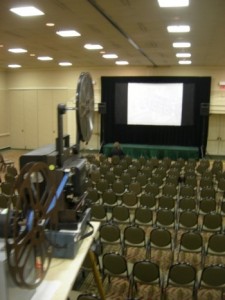 “Where else would you find a room full of men who want to have sex with dead actresses?”
“Where else would you find a room full of men who want to have sex with dead actresses?”
The late Phil Serling said it. He was talking about an event he helped create and run, Cinefest, a celebration of early–and obscure–silent and sound cinema.
Cinefest always was an eccentric event populated by eccentric people. Held each March in snowy Syracuse, N.Y., it truly was the world’s coolest uncool film festival.
This was a gathering of the faithful, many who grew up cherishing the eight- or nine-minute, condensed reel of 8mm or 16mm films of Laurel & Hardy, Abbott & Costello or W.C. Fields sold in the ’60s and ’70s in hard-to-find magazines or local camera stores. It is impossible to convey to a generation that can instantly call up entire features on their cell phones or find almost anything on YouTube the thrill of a new Castle Films or Blackhawk catelogue. Only at Cinefest could you find others with the same DNA, folks who scoured the Big Reel from cover to cover every issue even if it arrived a day late, which meant the best films available in ads from collectors had already been picked over for the month.

Word came down from the boys and girls of Syracuse last September in a letter to the regular attendees: this would be the last Cinefest. The four-day event ended Sunday, presumably with the scheduled screening of “The Sea Lion,” a 1922 feature starring Bessie Love. It was the first silent film screened at Cinefest 1 in 1981. You could say Cinefest stretched from Sea to Sea.
I started attending in the ’80s and was part of a Southern Ontario contingent that included film buffs Harry Purvis, Bill Stirrup and Bruce Jackson. Harry the Hat would see every damn film while Bill and Bruce moved hundreds of films salvaged from GTA libraries in the dealers room.
advertisement

There were always great discoveries to be made during the screenings. I never understood the power and charisma of screen legends such as Will Rogers, Gary Cooper, Carole Lombard, Conrad Veidt or Gloria Swanson until I saw them at their peak in silent films at Cinefest. These films were always accompanied by piano or organ, this year played by a rotating, all-star cast: Dr. Philip Carli, Makia Matsumura (who this year really brought the Colleen Moore pot boiler “Synthetic Sin” to life), Jon Mirsalis, Ben Model, Jeff Rapsis, Judith Rosenberg, Dr. Andrew Simpson and Gabriel Thibaudeau.
You would see crazy curiosities at Cinefest you’d never see even on YouTube or TCM, obscure B-movies and shorts or clips from lost films salvaged by collectors or archives. The George Eastman House, The Museum of Modern Art, The Library of Congress, New York University, UCLA Film Archives, Warner Bros and Paramount Pictures all contributed to this year’s effort.
The death knell for Cinefest was digital. A feature of the fest for years was the Saturday morning trip to a local movie palace, usually the Thomas Lamb-designed State theatre in downtown Syracuse, for a 35mm showcase. When film projection was yanked out of these neighbourhood cinemas the theatre day trips ended and with them part of the motive for making the trip from Toronto, Philadelphia, and beyond.

Digital projection intruded into the hotel ballroom screenings this year and it flopped. Pianists would have to freeze right along with the no longer moving images as the digital projectors went down and had to be re-booted. The usually clockwork precision of the Cinefest schedule fell behind each day. Fans might still be waiting to see Mary Pickford in “Tess of the Storm Country” (1914).
The old purr of the 16mm projectors was never a more welcome sound at Cinefest, a nice last laugh for the 100+-year-old medium.
I’ll also miss the dealer’s room, a place that should have been shut down a dozen years ago by eBay. It soldiered on, offering tables filled with obsolete media all carefully labeled and priced. I bought and sold many a film print over the years and made connections with many others who clung to this hobby way past its best before date. I grabbed a few last projection bulbs from Eric Nelsen, an A-V guy from Chester, N.Y. who will still sell you an exciter lamp for five bucks. Dealers would drive hundreds of miles with trucks jammed with films hoping to make some quick cash.
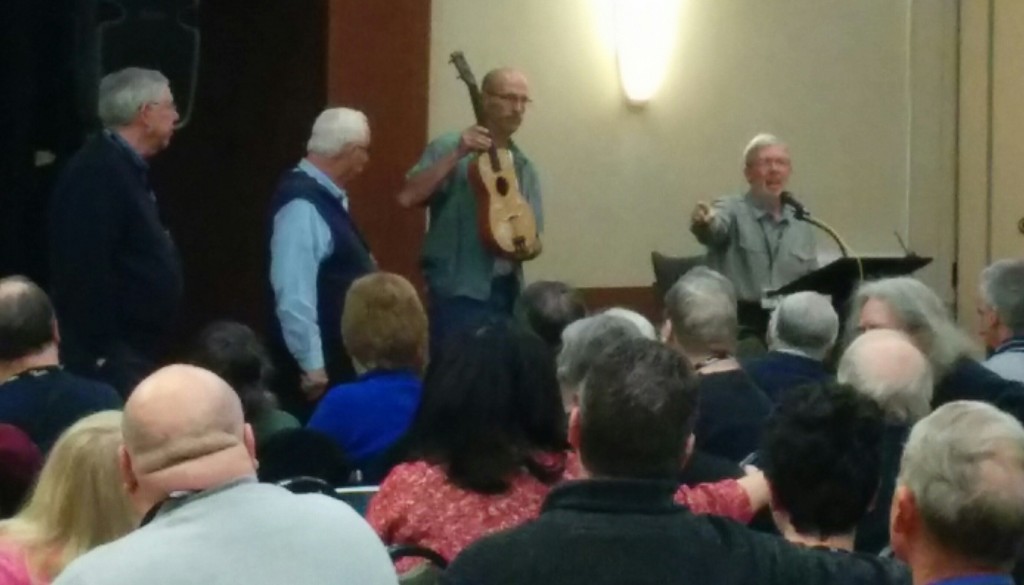
The final annual auction was held Sunday morning, with author/film critic Leonard Maltin as always presiding. Leonard kept things keen by mixing some sharp commentary into his patter, declaring the event might now be mainly of interest to media historians. Every format–16- and 35mm film, laser discs, VHS videotape, DVDs, BluRays, ancient magic lantern slides and even vinyl and audio cassettes get thrown into the auction mix. The shocker this year was the bidding frenzy over laser discs, a format that bloomed in the ’80s and then disappeared. Framed photos of Clark Gable brought little action, while a Groucho Marx sweater went for fifty bucks. Nobody in the room wanted a box full of 100 movie posters yet there was a bidder on a George Burns doll Maltin said looked like it was wearing Burns’ larger brother’s clothing.
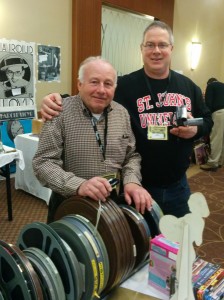
There was still passion for 16mm film collecting at Cinefest. I arrived half a day late, and as I wheeled my hotel dolly loaded with film and DVDs into the dealers room, the usual suspects pounced like ravens on a road kill. One whiff of new vinegar and these guys start to salivate.
The circle, however, got smaller each year. It was starting to tilt towards the scene in the 1939 MGM Hugh Harmon classic cartoon “Peace on Earth” where there were only two men left on earth, enemy soldiers, who aim their guns and kill each other.
What happens next is the squirrels and the bunnies and the skunks and the deer sort through the old ashes and rebuild. There is talk of that about Cinefest. One dealer has meetings scheduled for next week with a hotel in Buffalo. He’s hoping to launch a similar festival there by Sept., 2016. If it happens, I’ll be there.
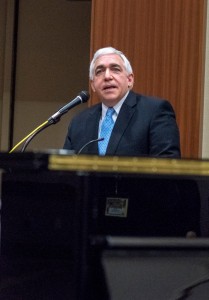
Syracuse Film Society president Gerry Orlando addressed a packed room Saturday night. Some of us in the crowd might have been hoping to hear a change of heart or reprieve for the fest but that was not offered. Cinefest had teetered towards extinction in the past–especially after the death of founder Phil Serling–only to amble on. Had he asked for a show of hands as to who in the room wanted the show to go on, well, that’s why committees make those decisions. Orlando had stated in a letter to attendees last September that he and the aging core group of Syracuse cinephiles wanted to go out more or less on top and judging by this year’s attendance, they did just that.
Orlando thanked the dedicated volunteers, many who had been there 30 years. These are the folks who manned the desk, sold tickets, programmed the films and set up at the hotel. He acknowledged the fear in the room that many old friends might never see each other again, and urged them to embrace this new fangled thing called Facebook.
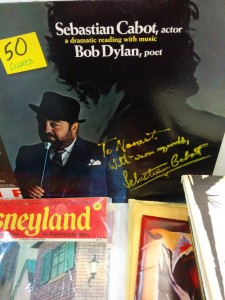
Cinefest always was an impossible dream: a 16mm film festival with no stars, red carpet or promotion, taking place off the New York Interstate in the dead of March. I’ve driven through the wildest snowstorms in my life getting there and back. If the roads didn’t kill you, the food at the Liverpool Holiday Inn might.
And yet I’ll miss the Cinefest scene more than the Dinosaur wings, the local hot dog diner Heid’s and other Syracuse signatures. Seeing it end is as painful and inevitable as Clarabelle the Clown saying “Goodbye Kids” on that final Howdy Doody episode, or the slow circle wipe of Chaplin shuffling off at the end of “The Circus.”
Maybe the end of “Modern Times” is a better fit. Like the great films it celebrated, Cinefest is now history. For classic films buffs, however, here’s to better days ahead.


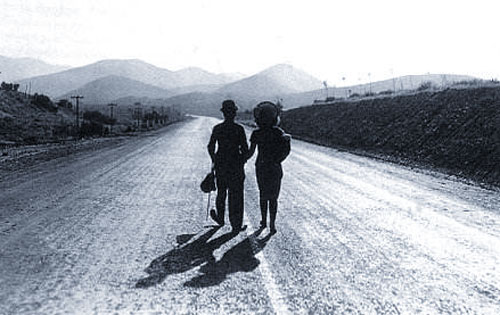




3 Comments
For the sake of accuracy, the Groucho Marx sweater sold for $36.00, not the $50.00 mentioned above. We will all miss Cinefest greatly, and look forward to seeing friends at future film shows.
Thanks for the correction Cynthia–but that’s still about $50 Canadian!!
Ha! Well played, sir.